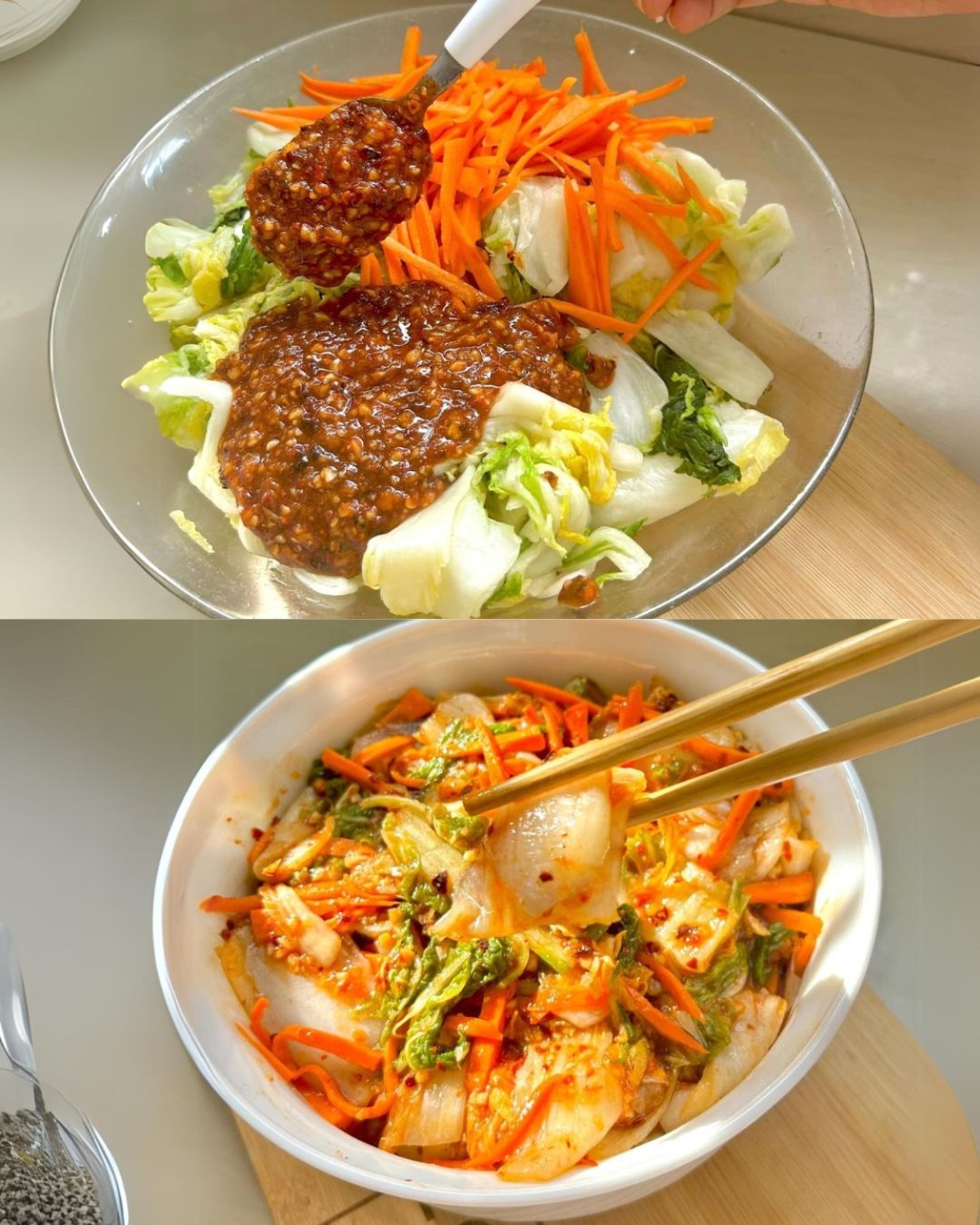This Homemade Napa Cabbage Kimchi is a flavorful and tangy Korean-inspired dish that’s perfect for adding a spicy kick to your meals. Made with Napa cabbage, carrots, and a blend of spices, this kimchi is not only delicious but also packed with probiotics, making it a healthy addition to your diet. It’s easy to prepare and can be enjoyed on its own, as a side dish, or added to various recipes for extra flavor.
Full Recipe:
Ingredients:
- Napa Cabbage: 1, sliced into preferred size
- Gochugaru Flakes or Fresh Red Chili: 2 tablespoons
- Ginger: 1 tablespoon, grated
- Garlic: 2 cloves, grated
- Carrots: 1-2, sliced
- Patis (Fish Sauce): 2 tablespoons
- Brown Sugar: 3 tablespoons
- Glutinous Rice Flour: 2 tablespoons
- Water: 1/4 cup
- Salt: For soaking the cabbage
Instructions:
- Prepare the Cabbage:
- Slice the Napa cabbage into your preferred size. Place the cabbage slices into a large bowl and generously sprinkle with salt. Toss to coat evenly.
- Let the cabbage sit for about 1-2 hours, tossing occasionally, until it wilts and releases moisture. This process helps to soften the cabbage and allows it to absorb the flavors better.
- Rinse and Drain:
- After the cabbage has wilted, rinse it thoroughly under cold water to remove excess salt. Drain well and set aside.
- Prepare the Rice Flour Paste:
- In a small saucepan, combine the glutinous rice flour and 1/4 cup of water. Stir well to dissolve the flour.
- Cook the mixture over medium heat, stirring constantly, until it thickens into a smooth paste. This should take about 3-5 minutes. Remove from heat and let it cool to room temperature.
- Make the Kimchi Paste:
- In a large mixing bowl, combine the gochugaru flakes or fresh red chili, grated ginger, grated garlic, patis (fish sauce), and brown sugar.
- Add the cooled rice flour paste to the mixture and stir until everything is well combined, forming a thick, spicy paste.
- Mix the Vegetables:
- Add the sliced carrots and the drained Napa cabbage to the bowl with the kimchi paste. Use your hands (wear gloves to protect your skin from the chili) to mix the vegetables and the paste together, ensuring that every piece of cabbage and carrot is evenly coated with the spicy mixture.
- Pack and Store:
- Pack the kimchi tightly into a clean, airtight glass jar or container, pressing down to remove any air bubbles. Leave some space at the top to allow for fermentation.
- Seal the jar and let it sit at room temperature for 1-2 days to ferment. The longer it ferments, the tangier it will become. After fermentation, store the kimchi in the refrigerator.
- Serve:
- Your homemade kimchi is now ready to be enjoyed! Serve it as a side dish, add it to your favorite recipes, or enjoy it on its own.
Additional Information
Tips:
- Fermentation Time: If you prefer a milder flavor, you can refrigerate the kimchi immediately after mixing, but for a more traditional tangy taste, allow it to ferment at room temperature for a couple of days before refrigerating.
- Spice Level: Adjust the amount of gochugaru flakes or fresh chili to your preferred spice level. For a milder kimchi, use less chili, and for a spicier kick, add more.
- Alternative Seasonings: You can add other ingredients like chopped green onions, radish, or even a bit of soy sauce for additional depth of flavor.
Storage Tips:
- Refrigeration: Store the kimchi in an airtight container in the refrigerator. It will continue to ferment slowly in the fridge and develop deeper flavors over time. Properly stored, kimchi can last for several months.
- Serving Tip: Always use a clean utensil to remove kimchi from the jar to prevent contamination and extend its shelf life.
Nutritional Benefits:
- Napa Cabbage: Rich in vitamins C and K, as well as fiber, which aids digestion.
- Ginger and Garlic: Both have anti-inflammatory and immune-boosting properties.
- Probiotics: The fermentation process creates beneficial probiotics, which support gut health.
Nutritional Facts (per serving, approximately):
- Calories: 50
- Protein: 2g
- Fat: 0g
- Carbohydrates: 10g
- Fiber: 2g
- Sodium: 500mg
Possible Questions:
- Can I make kimchi without fish sauce?
Yes, you can substitute fish sauce with soy sauce or a vegan fish sauce alternative to make the kimchi vegetarian or vegan. - How do I know if my kimchi is fermenting properly?
You should see small bubbles forming in the jar, and the kimchi will develop a tangy, sour smell. This indicates that the fermentation process is working. - Can I add other vegetables to this kimchi recipe?
Absolutely! You can add radishes, green onions, or daikon for extra crunch and flavor. - What if my kimchi tastes too salty?
If the kimchi tastes too salty after fermentation, you can rinse it lightly before serving or mix it with a bit of fresh cabbage to balance the flavor. - Is it necessary to use glutinous rice flour?
Glutinous rice flour helps to create a thick paste that clings to the vegetables, but you can skip it if you don’t have any. The kimchi will still turn out delicious. - How long does homemade kimchi last?
Properly stored in the refrigerator, kimchi can last for several months, and it often tastes better as it ages. - Can I speed up the fermentation process?
Yes, you can place the kimchi in a warm spot in your kitchen to speed up fermentation, but be sure to check it daily to avoid over-fermentation. - What can I do if my kimchi is too spicy?
You can balance out the spice by adding more sliced carrots or fresh cabbage to the mix before serving. - Can I use a different type of cabbage for kimchi?
Yes, while Napa cabbage is traditional, you can experiment with other cabbages like green cabbage or savoy cabbage for a different texture. - How should I serve kimchi?
Kimchi can be enjoyed as a side dish, added to soups, stews, stir-fries, or even on top of rice or noodles for an extra burst of flavor.
Conclusion:
This Homemade Napa Cabbage Kimchi is a flavorful, spicy, and tangy dish that adds a burst of flavor to any meal. Easy to make and full of beneficial probiotics, this kimchi is not only delicious but also a great way to incorporate more fermented foods into your diet. Whether you’re a seasoned kimchi lover or new to fermented foods, this recipe is sure to become a favorite. Enjoy your kimchi as a side dish, a condiment, or an ingredient in your favorite recipes—it’s versatile, healthy, and always satisfying!

